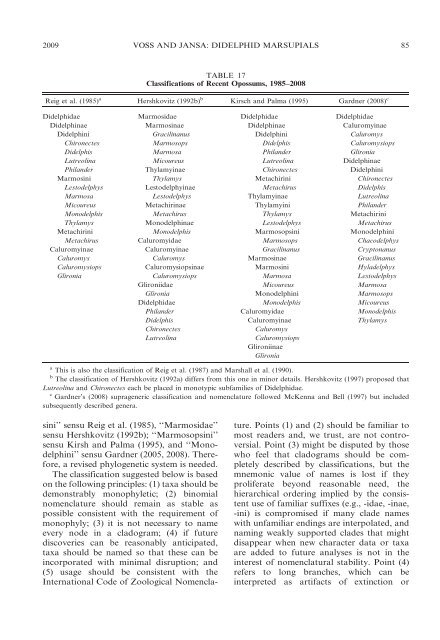phylogenetic relationships and classification of didelphid marsupials ...
phylogenetic relationships and classification of didelphid marsupials ...
phylogenetic relationships and classification of didelphid marsupials ...
You also want an ePaper? Increase the reach of your titles
YUMPU automatically turns print PDFs into web optimized ePapers that Google loves.
2009 VOSS AND JANSA: DIDELPHID MARSUPIALS 85<br />
Reig et al. (1985) a<br />
sini’’ sensu Reig et al. (1985), ‘‘Marmosidae’’<br />
sensu Hershkovitz (1992b); ‘‘Marmosopsini’’<br />
sensu Kirsh <strong>and</strong> Palma (1995), <strong>and</strong> ‘‘Monodelphini’’<br />
sensu Gardner (2005, 2008). Therefore,<br />
a revised <strong>phylogenetic</strong> system is needed.<br />
The <strong>classification</strong> suggested below is based<br />
on the following principles: (1) taxa should be<br />
demonstrably monophyletic; (2) binomial<br />
nomenclature should remain as stable as<br />
possible consistent with the requirement <strong>of</strong><br />
monophyly; (3) it is not necessary to name<br />
every node in a cladogram; (4) if future<br />
discoveries can be reasonably anticipated,<br />
taxa should be named so that these can be<br />
incorporated with minimal disruption; <strong>and</strong><br />
(5) usage should be consistent with the<br />
International Code <strong>of</strong> Zoological Nomencla-<br />
TABLE 17<br />
Classifications <strong>of</strong> Recent Opossums, 1985–2008<br />
Hershkovitz (1992b) b<br />
Kirsch <strong>and</strong> Palma (1995) Gardner (2008) c<br />
Didelphidae Marmosidae Didelphidae Didelphidae<br />
Didelphinae Marmosinae Didelphinae Caluromyinae<br />
Didelphini Gracilinanus Didelphini Caluromys<br />
Chironectes Marmosops Didelphis Caluromysiops<br />
Didelphis Marmosa Phil<strong>and</strong>er Glironia<br />
Lutreolina Micoureus Lutreolina Didelphinae<br />
Phil<strong>and</strong>er Thylamyinae Chironectes Didelphini<br />
Marmosini Thylamys Metachirini Chironectes<br />
Lestodelphys Lestodelphyinae Metachirus Didelphis<br />
Marmosa Lestodelphys Thylamyinae Lutreolina<br />
Micoureus Metachirinae Thylamyini Phil<strong>and</strong>er<br />
Monodelphis Metachirus Thylamys Metachirini<br />
Thylamys Monodelphinae Lestodelphys Metachirus<br />
Metachirini Monodelphis Marmosopsini Monodelphini<br />
Metachirus Caluromyidae Marmosops Chacodelphys<br />
Caluromyinae Caluromyinae Gracilinanus Cryptonanus<br />
Caluromys Caluromys Marmosinae Gracilinanus<br />
Caluromysiops Caluromysiopsinae Marmosini Hyladelphys<br />
Glironia Caluromysiops Marmosa Lestodelphys<br />
Glironiidae Micoureus Marmosa<br />
Glironia Monodelphini Marmosops<br />
Didelphidae Monodelphis Micoureus<br />
Phil<strong>and</strong>er Caluromyidae Monodelphis<br />
Didelphis Caluromyinae Thylamys<br />
Chironectes Caluromys<br />
Lutreolina Caluromysiops<br />
Glironiinae<br />
Glironia<br />
a<br />
This is also the <strong>classification</strong> <strong>of</strong> Reig et al. (1987) <strong>and</strong> Marshall et al. (1990).<br />
b<br />
The <strong>classification</strong> <strong>of</strong> Hershkovitz (1992a) differs from this one in minor details. Hershkovitz (1997) proposed that<br />
Lutreolina <strong>and</strong> Chironectes each be placed in monotypic subfamilies <strong>of</strong> Didelphidae.<br />
c<br />
Gardner’s (2008) suprageneric <strong>classification</strong> <strong>and</strong> nomenclature followed McKenna <strong>and</strong> Bell (1997) but included<br />
subsequently described genera.<br />
ture. Points (1) <strong>and</strong> (2) should be familiar to<br />
most readers <strong>and</strong>, we trust, are not controversial.<br />
Point (3) might be disputed by those<br />
who feel that cladograms should be completely<br />
described by <strong>classification</strong>s, but the<br />
mnemonic value <strong>of</strong> names is lost if they<br />
proliferate beyond reasonable need, the<br />
hierarchical ordering implied by the consistent<br />
use <strong>of</strong> familiar suffixes (e.g., -idae, -inae,<br />
-ini) is compromised if many clade names<br />
with unfamiliar endings are interpolated, <strong>and</strong><br />
naming weakly supported clades that might<br />
disappear when new character data or taxa<br />
are added to future analyses is not in the<br />
interest <strong>of</strong> nomenclatural stability. Point (4)<br />
refers to long branches, which can be<br />
interpreted as artifacts <strong>of</strong> extinction or

















